Cocktail Queries: 5 Questions about Bourbon
Photos via Jim Beam, Maker's Mark, Four Roses, Bulleit Bourbon, Jim Vorel Drink Features whiskey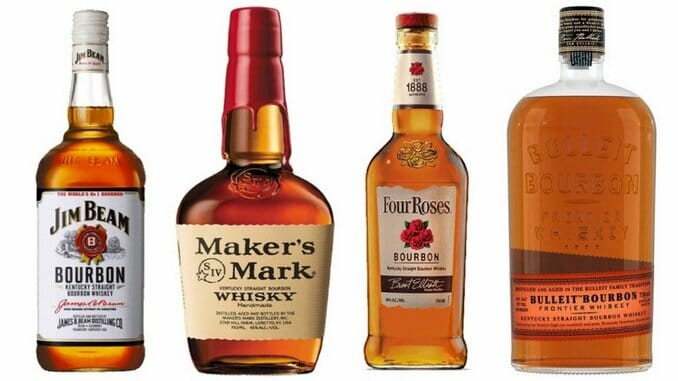
Cocktail Queries is a Paste series that examines and answers basic, common questions that drinkers may have about mixed drinks, cocktails and spirits. Check out every entry in the series to date.
In our previous, rye whiskey-centered entry in this “5 questions” format, I delved a bit into the fact that it was rye, rather than any other form of whiskey, that was America’s first great contribution to the spirits world.
When all is said and done, however, you know what it is that you think of first, when you think of American whiskey. And the answer is obviously “bourbon.”
There’s just something magical and endlessly idealized about bourbon in modern American popular culture. The very name drips with the promise of nectar. It evokes everything from down-home southern hospitality and dessert confections to the romanticized freedom of the American Old West, and is endlessly name-dropped in pop country standards. You don’t see platinum music artists singing about rye whiskey and classic cocktails, but they do constantly reference bourbon. It’s the corner of the whiskey world that has achieved truly universal saturation in the U.S., being the domain of both the blue collar everyman and the insufferable finance bro in equal measure. Whereas single malt scotch will likely always carry a connotation of snobbiness, bourbon implies accessibility, even as the price of bourbon has climbed to new heights over the last decade.
It’s a bit weird to think, then, that 20 years ago the bourbon industry was positively quaint and atrophied, compared to the megalith it’s become today. A whiskey-drinking recession that began in the 1970s had continued for three decades, leaving the bourbon category as a collection of dusty bottles from aged distilleries, choking the shelves of package stores. It was the launching point for a remarkable comeback, which would see the number of bourbon distilleries explode as the category was reborn, broadened and infused with the spirit of a new generation of craft distillers. Today, bourbon is bigger than it’s ever been, which means there are still plenty of newcomers in the category with burning questions to ask.
Here, then, are five questions about bourbon you’ll probably want answered. Also: Check out our blind tasting of 13 bottom-shelf, budget bourbon brands to find the best value in the segment.
1. What is the U.S. definition of bourbon?
A bottle of bourbon whiskey sold in the U.S. must meet the following requirements:
— It’s made from a mash bill of at least 51% corn. Corn is the defining grain of the classic Kentucky bourbon flavor profile, and it often makes up around 70% of the mash bill or more. Traditionally, the rest of the mash bill is made from “flavoring grains” such as rye and malted barley, with a small amount of barley providing a subtle flavor contribution along with helpful enzymes for fermentation before distillation. However, the rye and malted barley can be swapped out for other grains as well, including wheat … or oats, spelt, triticale, whatever. The resulting whiskey can still be “bourbon,” as long as it’s 51% corn.
— The distilled spirit is aged in newly charred American oak barrels. The “newly charred” aspect is integral to the bourbon flavor profile, contributing the deep notes of char and freshly roasted oak (and its accompanying vanilla/caramel notes) that pretty much all bourbons share. Only newly charred oak will deliver this intensity of flavor and degree of color, especially in short durations of aging. Aging in used barrels, on the other hand, as is standard in the Scottish whisky industry, is a gentler process that takes much longer to contribute flavor and color, which is why the average age-stated scotch is so much older than the average age-stated bourbon.
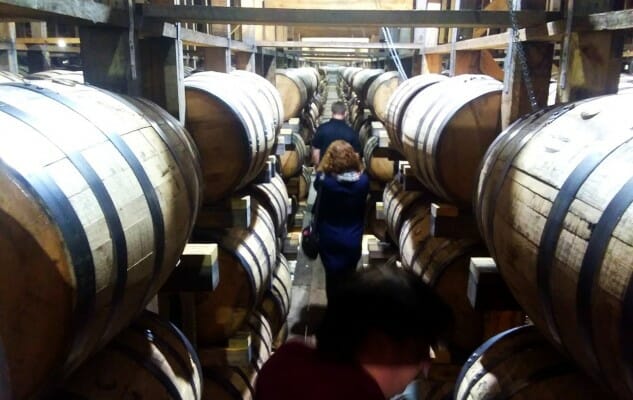 There can be no bourbon without newly charred oak barrels, like these ones at Four Roses.
There can be no bourbon without newly charred oak barrels, like these ones at Four Roses.
— Bourbon can be distilled to no more than 160 proof, which leaves more grain-derived flavors in the spirit than distilling to even higher levels, and must enter the barrel at a proof no higher than 125. Proof can fluctuate substantially within the barrel, however, as both alcohol and water evaporation takes place and changes the overall strength of the product—this is how you can find a cask-strength bourbon that is 130 or 140 proof. After aging and dilution, though, the whiskey is federally required to be bottled at a strength of at least 80 proof (40% ABV).
— Of note: There is no minimum specific duration for bourbon aging—there’s “bourbon” on the shelves that has been in oak for only a few months, but it’s not the kind of thing you’d want to drink. This spirit really needs at least a year or two in order to round into potable form, and thankfully the label straight bourbon makes this clear to the consumer. A product labeled as “straight” bourbon has been aged for a minimum of two years, with no additional colors or flavorings, and is what many whiskey geeks would consider the baseline for a quality product. The federal definition for “straight” also requires that any straight bourbon aged for less than four years must include its specific age statement on the label, so if you see something simply labeled “straight bourbon” with no additional age statement, you know that product is at least four years old.
— “Bottled-in-Bond” can be considered a further upgrade to the quality standards of straight bourbon, being defined as a bourbon that has been aged for at least four years in a federally bonded, supervised warehouse and bottled at a strength of 100 proof (50% ABV). The label of a bottled-in-bond bourbon must include additional information, including where it was distilled, where it was bottled and its distillation season. This is a category that had been fading away by the early 2000s, as “4-year bourbon” isn’t a particularly impressive achievement to the older powerhouse distilleries of the industry. However, the rise of younger craft distillers has revitalized the term, as it’s now come to represent the payoff of years of patient waiting on the part of this new generation. Likewise, the bigger players in the bourbon industry have seized upon the newfound popularity of “bottled-in-bond,” releasing premium bottled-in-bond bourbons that are far older than the baseline requirement of four years.
2. Does bourbon have to be made in Kentucky?
Simple answer: No, bourbon doesn’t need to be distilled, aged or bottled in Kentucky in order to qualify as bourbon. This is a persistent bit of misinformation in the whiskey space, one that gained a foothold and has been hard to dislodge as a likely sounding piece of “bar trivia” in the decades that followed. Personally, I get a sense that it’s the residents of Kentucky that are often pushing the perpetuation of this particular myth, not out of a specific desire to misinform but due to state pride in Kentucky’s role as bourbon’s origin point. That loyalty to state product, as heard in phrases like “it’s not real bourbon if it’s not from Kentucky,” can give rise to misconceptions, especially among drinkers from other states.
The style of whiskey we now define as bourbon did indeed begin in Kentucky, but it is now produced in every other U.S. state, and they’re all perfectly valid as bourbon. Mega distilleries like MGP of Indiana in particular produce copious amounts of bourbon, the majority of which is purchased by smaller distillers or independent bottlers throughout the U.S. as a contracted product to be released under a plethora of names. Many Kentucky whiskey distilleries likewise produce bourbon on a contract basis, selling it to craft distilleries or boutique bottlers to use in blends or one-off releases.
When it comes to the most recognizable distillery names in the industry, however, Kentucky does remain the center of the bourbon universe. A quick survey of all the brands that call Kentucky home—Jim Beam, Maker’s Mark, Old Forester, Buffalo Trace, Wild Turkey, Four Roses, Heaven Hill, Bulleit, Michter’s and many others—make this quite clear.
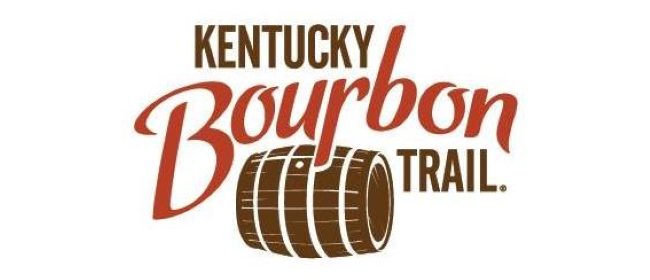 The Kentucky Distillers’ Association runs the Kentucky Bourbon Trail program to drive whiskey tourism to the state of Kentucky.
The Kentucky Distillers’ Association runs the Kentucky Bourbon Trail program to drive whiskey tourism to the state of Kentucky.
3. What about “Tennessee whiskey”? Is that also bourbon?
When it comes to American whiskey, Jack Daniel’s is like the elephant in the room. It’s the biggest whiskey brand in the country, and most Americans absolutely seem to think of it as bourbon, but it instead carries the label “Tennessee whiskey.” What’s the difference? Is there a difference?
In reality, Jack Daniel’s could absolutely bear the title “bourbon” if the owners at Brown-Forman so chose. It meets all the same federal requirements to be bourbon, as do most of the other classic whiskey brands in the state, such as Dickel. Rather, the “Tennessee whiskey” title is a combination of state pride and marketing tool to make the state’s whiskey production seem more distinctive and specialized.
On a state level, the defining difference between “bourbon” and Tennessee whiskey is the requirement that Tennessee-produced whiskeys (with a few exceptions) undergo what is called the Lincoln County Process. This is the filtering of newly distilled whiskey before aging through fresh sugar maple charcoal, a procedure that is claimed to “improve the flavor” of the spirit, although whiskey professionals disagree about its actual flavor contribution to the finished product. Regardless, you can safely think of these Tennessee whiskeys as being akin to bourbon, as long as they’re still based around a mash of at least 51% corn.
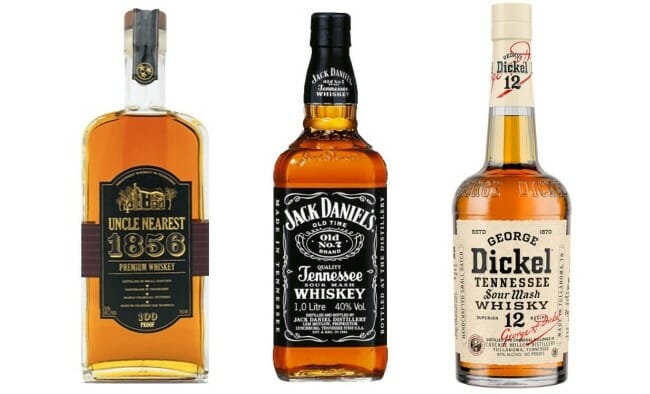 A few popular Tennessee whiskeys.
A few popular Tennessee whiskeys.
4. Why have bourbon prices increased so much?
Oh, to go back in time to around 15 years ago, when the bourbon boom was just getting its feet under it, new products were beginning to appear on the shelves, and quality products were all cheap as hell. Those days are long since gone, but my, if you knew then what was about to happen … well, you could assemble a whiskey collection that would quickly be worth millions, by focusing on everything Buffalo Trace alone.
If you’ve been following the whiskey world for more than a few years, you’ve no doubt noticed the price tags creeping upward. This is a climb that has been only more pronounced if you’ve been into bourbon for more than a decade, as those more seasoned fans have watched the package store shelves change before their very eyes.
Sadly, it’s a direct result of bourbon’s surge in popularity, and especially the hype that has been built for the portfolios and limited releases of specific distilleries. The desire for limited releases, coupled with phenomena like the craze for Pappy Van Winkle, drove the market for ultra-luxe releases to new heights, which had the side effect of normalizing the idea of spending $100 or more on a bottle of bourbon. This likewise dragged up the prices of the bottom and mid-shelf along with it. Whereas 15 years ago, spending $50 on a bottle of bourbon would have seemed patently unnecessary, now it’s solidly in the heart of the mid-shelf, and nowhere near “splurge” territory for many.
This has also resulted in some distilleries “premiumizing” brands that were once more affordable. Kentucky’s Heaven Hill is a good example, as they transformed Old Fitzgerald from a dusty, bottom shelf, 4-year-old bottled-in-bond wheated bourbon into a 15-year-old product in a beautiful decanter that now retails for $150. On a smaller, but perhaps more pertinent level, Heaven Hill discontinued its classic 6-year-old bottled-in-bond bourbon, only to bring it back a year later as a 7-year-old expression, with a price tag that went from $15 to $40 in the process. It’s just the price the consumer must pay for the whiskey industry being in a boom period.
5. How much should I pay for bourbon?
If the price of bourbon has increased across the board, then you might find yourself wondering “Hey, what is reasonable to pay for whiskey?” That’s of course up to each and every consumer, and their own budget, but allow us to offer our own outlook on what constitutes a good bourbon price point these days.
Perfectly enjoyable, tasty, rock solid budget bourbon can be found for as little as $10 or less per 750 ml bottle, provided you know where to look. In particular, brands like Heaven Hill’s Evan Williams, Barton 1792’s Very Old Barton, or Buffalo Trace’s Benchmark Old No. 8 are what we turn to when looking for cheap, tasty whiskey—I refer you once again to our blind tasting of 13 budget bourbon brands for more details. These brands aren’t going to impress people, and they’re undeniably on the bottom shelf, but they stand up in blind tasting. In fact, you’ll find some bourbons here that blow away competition from more recognizable brands like Jim Beam and Jack Daniel’s.
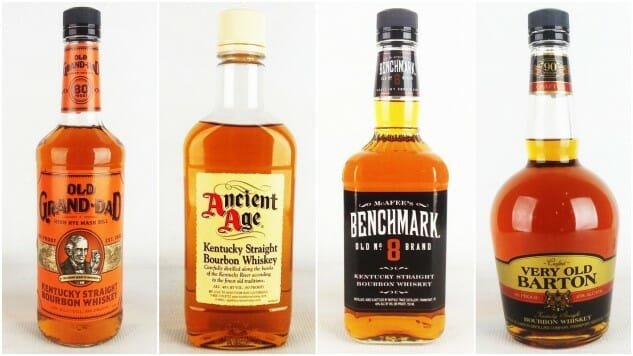 Some bottom shelf representatives.
Some bottom shelf representatives.
Beyond $20 or $25, you start to get into what we’d call the bourbon mid-shelf, where you can reasonably expect a higher level of quality, and often a slightly higher proof. You’ll start to see some of the industry’s “small batch” bourbons—check out our piece on small batch bourbons for more details—with many of them (such as Knob Creek, Four Roses, Maker’s Mark, Elijah Craig, etc) hovering in the $30 range. Many of these bourbons are some of our favorite daily drinkers, and they fall at a nice price point where you don’t feel bad about using them as mixers/in cocktails, but are also enjoyable to drink neat. A lot of bourbon from craft distilleries can also be found at this level, as they often need to charge higher prices to make up for their lack of bulk sales. The mid-shelf continues to around $50 or beyond, depending on the definition of the consumer. The point is, you can absolutely get by without spending more than this, and enjoy excellent bourbon.
Beyond the $60 point, things become more specialized. You’ll find more single barrel releases, higher age statements, barrel-proof releases and special cask finishes/gimmicks here. As the dollar figures continue to climb, the concept of “value” becomes increasingly difficult to assess, until it essentially becomes definable on a case-by-case basis. There’s no upper limit on what bourbon can cost—it’s just a matter of what obsessive collectors are willing to pay. Thankfully, there’s nothing to stop the rest of us from appreciating the values that still remain in the industry.
Jim Vorel is a Paste staff writer and resident liquor geek. You can follow him on Twitter for more drink writing.